|
photographing County Gate
When we began building this model, I depended
upon my son, who owned and all singing and dancing digital camera which
probably also made espresso! That is until I bought a Panasonic Lumix
DMC-FX30. This tiny camera has an excellent lens, zoom and a macro facility
and takes things with top class resolution. I never use flash as this just
does not work but rather the strip lighting in my workshop.

This is a point and shoot affair and I shoot a
lot. I then examine them on my computer and select the best. I do sometimes
do colour compensation etc using Photoshop. Our backdrops have a blue sky. A
mat vinyl film is bonded to the prints which gives depth and some durability.
While the eye sees the sky as blue, cameras, some some reason, often sees it
as turquoise. A mystery of life!
Only too often, therefore, I have to remove the
sky and replace it with the original artwork using Photoshop.
The small size does make it harder to keep still
but one just takes a load of shots...who cares?
Even better shots can be had by using extra
lighting.
The Lumix finally gave out after being dropped
and it has been replaced by a Lumix DMC TZ8. This is a more 'grown up'
camera and allows for manual setting as well as point and shoot. It has a
lerger excellent Leica lens.

the minicam of Bob Barnard
Long time L&B 009 modeller Bob Barnard produced
this minicam some time ago and has kindly operated it at County Gate a number
of times. This have found their way onto YouTube as well as onto this site.
We have never had enough time so rather sadly, so far, some of the films are
shown with trains going too fast!
The best videos of a model railway I have seen
are by Ted Polet (Netherlands) who has taken a series of his inspirational
009 Craigcorrie & Dunalistair railway. I am grateful for his permission to
publish them here.
He writes:
"The natural slow running
seen in these videos was achieved by using a Kent Panel Controls feedback
controller. Most of the locomotives respond quite well to these, even if they
are fitted with standard motors. Despite what I thought was scale speed, I
often had to doctor the sound tracks to speed up the exhaust beats!
I used a simple DV camera, a
Canon MV800, set to 16x9 PAL format. The camera was mounted on an old SLIK
tripod which still works well enough even for video. The raw video tracks
were cut using
VirtualDub (a
free package to be found on the Internet), and the sound track assembled from
sometimes literally 10 parallel source tracks, using another freeware program
called
Audacity.
The sound sources are various old VHS tapes, my own steam recordings
of 30 or more years ago, downloaded sound effects and even sound effects from
my own holiday videos.
This all sounds easy, but it
takes a lot of practice to learn to know these tools. The clips shown on this
page were extracted from the Digital Video source files and reduced to 1 -
2Mb size. The sound may be slightly distorted which is due to the WMV format
of the clips, not to the original track.
Click on a picture to start
the video. Note that in Firefox one needs a video plug-in to be able to play
the file from the website."
|
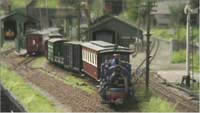 |
The branch mixed, hauled by the ex-Darjeeling 'B' class
loco 'Shiva', enters Rae Bridge and sets back into the platform road. The
sound is of a real Darjeeling loco on an old VHS tape, heavily edited. |
|
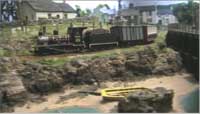 |
As the surf roars on the rocks below and the gulls cry,
a local passenger train hauled by the ex-Beira Railway 'Lawley', departs
from Dunalistair, skirting the headland. Again the sound is from the real
'Lawley' at the Sandstone estate in South Africa, heavily edited and
adapted to the model environment. |
|
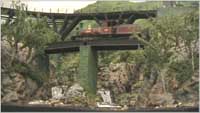 |
The mid-day goods service to Craigcorrie works upgrade
across the lower bridge in the Glenclachan Gorge, headed by no. 16 'Ariadne'.
The sound was taken from a Dutch RTM tram engine working flat-out against
a gradient, which I recorded on tape 30 years ago. |
|
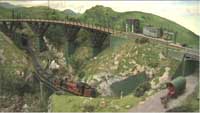 |
The evening coal train, headed by the Garratt loco no. 8
'Gaidheal', descends through the Glenclachan Gorge towards Rae Bridge. The
sound is from a tape of the Alfred County Railway by Ian Turner, heavily
edited. |
|
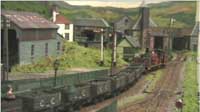 |
The evening coal train departs from Rae Bridge. Again,
the sound is from a tape of the Alfred County Railway by Ian Turner. |
|
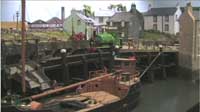 |
The 0-4-2ST 'Greta', acting as the day's harbour
shunter, shunts coal tubs at Dunalistair. The sound was heavily adapted
from a downloaded soundtrack of Ffestiniog Railway 'Prince', with exhaust
bursts isolated and speeded up, blower, wheels, and coupling sound, and
echoes added. |
|
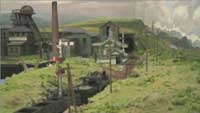 |
The empty coal train with no. 7 'Brahma', arrives at
Inverlochan. As the train draws into the colliery yard, the driver
whistles for the brakeman to screw down his brake and help bring the train
to a stop. The sound comes from another South African loco, a NG15
|
|
click here |
'Jock' the shay |
|
click here |
Tralee and Dingfle revisited! |

|